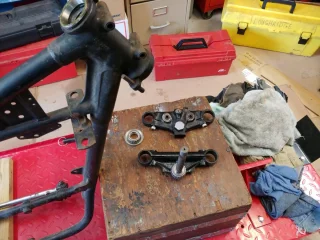seattle##gs
VIP MEMBER
- Joined
- Oct 28, 2014
- Messages
- 2,104
somebody dropped off a 1970 TR6 - spring gold - for a small electrical bug and I have been looking at it for a few days. It is absolutely gorgeous viewed from any direction. I really like my Atlas but this Triumph makes it look ordinary. I took a short test ride and it performed well but the front end is wiggly at best. I roll it in and out of my garage along with a 78 Triumph and my Atlas. The forks are uninspiring. I know they are just a tube with a spring. So my question is...Has anyone here put on the front end from an Atlas onto a pre-OIF Triumph? It seems like an excellent idea and would look similar to the Triumph...at least they are from the same era. The hardest part would be the steering stem. If the Triumph handled as good as it looks it would be a terrific bike.


